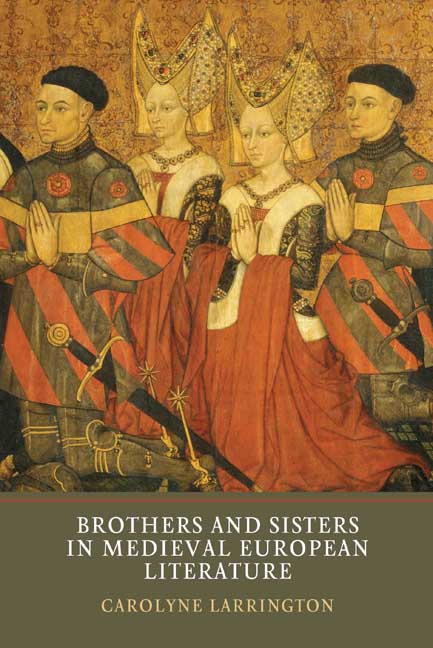Book contents
- Frontmatter
- Dedication
- Contents
- Acknowledgements
- Abbreviations
- Introduction
- 1 The Medieval Sibling in History
- 2 ‘Berr er hverr á bakinu nema sér bróður eigi’: Fraternal Love and Loyalty
- 3 ‘Io v’ho cara quanto sorella si dee avere’: Sisters, and their Brothers
- 4 ‘Næs þæt andæges nið’: Fraternal Hatreds
- 5 ‘Te souviegne de ce que je suis ta seur’: Sisters and Hostility
- 6 ‘The king’s dochter gaes wi child to her brither’: Sibling Incest
- 7 ‘So wil ich dir ce wibe mine swester gebn’: When Siblings Marry
- 8 ‘Trewethes togider that gun plight’: Fictive Siblings
- Conclusion
- Bibliography
- Index
- Frontmatter
- Dedication
- Contents
- Acknowledgements
- Abbreviations
- Introduction
- 1 The Medieval Sibling in History
- 2 ‘Berr er hverr á bakinu nema sér bróður eigi’: Fraternal Love and Loyalty
- 3 ‘Io v’ho cara quanto sorella si dee avere’: Sisters, and their Brothers
- 4 ‘Næs þæt andæges nið’: Fraternal Hatreds
- 5 ‘Te souviegne de ce que je suis ta seur’: Sisters and Hostility
- 6 ‘The king’s dochter gaes wi child to her brither’: Sibling Incest
- 7 ‘So wil ich dir ce wibe mine swester gebn’: When Siblings Marry
- 8 ‘Trewethes togider that gun plight’: Fictive Siblings
- Conclusion
- Bibliography
- Index
Summary
Unofficial, popular or folk theories of sibling psychologies and how these relate to children and to adults have become assimilated into our thinking about family relationships in the West in the twenty-first century. Although Freud sheered away from close analysis of the sibling bond, he formulated the insight that, in the case of siblings: ‘an intimate friend and a hostile enemy’ ‘come together in a single individual’. Freud's observation lacks nuance of course; he takes little account of how sibling relationships are conditioned by gender, by birth order, and by varying socio-historical factors, but his identification of the ambivalences of siblinghood is acute. Psychologists, particularly those who have conducted lifespan investigations into sibling relationships, have thickened and complicated our perceptions of sibling, affine and fictive sibling relationships. The work of developmental and cross-cultural psychologists, along with the close focus Juliet Mitchell brings to her psychoanalytical framing of sibling questions, has provided new theoretical bases for considering the relationship, even if the outcome of these analyses is generally to confirm the unofficial beliefs we hold about the bond. We recognize these ambivalences from our own childhood sibling experiences, and that these formative experiences inflect our relationships with our peers, with our friends, and, very particularly, with our in-laws.
But can we project modern sibling theory back a millennium to explain the sibling dynamics in medieval culture? I argue that the answer is a qualified yes. Siblings are born into a family usually consisting of two parents, and although medieval families were prone to disruption – through high mortality rates for parents and children, through the acquisition of half-, step-, adopted and foster-sibs – so too are modern Western families, through separation, divorce, remarriage, fostering, adoption and other, less formal, processes. The historical realities for siblings between 500 and 1500 were extremely various, as various as those today, but the essential parameters of brothers’ and sisters’ feelings for one another: of love, of hatred, of loyalty and rivalry remain unchanged.
The social conditions under which those dynamics find particular expression were of course very different in the medieval period. Children lost their parents and siblings very young, they might be forced into the labour market while not yet adolescent, or be trained up for particular vocations with little consultation as to individual wishes.
- Type
- Chapter
- Information
- Brothers and Sisters in Medieval European Literature , pp. 235 - 238Publisher: Boydell & BrewerPrint publication year: 2015



